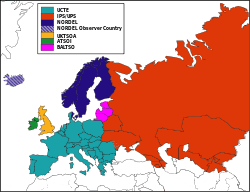IPS/UPS
The IPS/UPS is a wide area synchronous transmission grid of some CIS countries with a common mode of operation and centralized supervisory control. It has an installed generation capacity of 300 gigawatts, and produces 1,200 terawatt-hours (TWh) per year for its 280 million customers. The system spans eight time zones.[1]

History
The creation of the unified power system started in 1956 by interconnecting the power systems of Center and Middle Volga. By 1978, the unified power system included all of the Soviet Union, excluding Central Asia. In addition, in 1979–1993 the power systems of Poland, German Democratic Republic, Czechoslovakia, Hungary, Romania and Bulgaria, now part of the synchronous grid of Continental Europe (ENTSO-E), operated synchronously with the Unified Power System of USSR. Central Asian countries (excluding Turkmenistan) were included to the integrated system in 2001.[1] In 2009, Uzbekistan disconnected from the system resulting also in the disconnection of Tajikistan.[2]
UPS
The Russian portion of the interconnection is known as Unified Power System of Russia (UPS) (Russian: Единая энергетическая система России) and includes six regional transmission operators: ECO Center, ECO South, ECO North-West, ECO Middle Volga, ECO Urals and ECO Siberia. ECO East operates in isolation from UPS of Russia.
UPS of Russia came into existence as a result of Russian Federation Decision #526 dated 11 July 2001 "On the Restructuring of the Russian Federation United Energy System". Up until 1 July 2008 RAO UES operated UPS. It is currently being operated by the Federal Grid Company (FGC UES) of Russia.
IPS
The Integrated Power System (IPS). portion of the network includes the national networks of Ukraine, Kazakhstan, Kyrgyzstan, Belarus, Azerbaijan, Tajikistan, Georgia, Moldova and Mongolia.[3]
Interconnections with other systems
IPS/UPS is synchronously interconnected with the Baltic countries. In addition, it has an interlink to the Nordic system via a back to back High Voltage Direct Current (HVDC) connection in Finland with a capacity of 1420 megawatts.[4]
Russia and the EU are considering unifying the IPS/UPS network with the ENTSO-E to form a single synchronous super grid spanning 13 time zones.[1] There is also a proposal to interconnect the Russian grid to China and other Asian systems with HVDC links as part of an Asian Super Grid.
See also
- European Network of Transmission System Operators for Electricity (ENTSO-E)
- SuperSmart Grid - proposal for combining ENTSO-E, IPS/UPS and some Middle East networks with smart grid capabilities
- Super grid
- European super grid
- Asian Super Grid
References
-
Sergei Lebed (20 April 2005). "IPS/UPS Overview" (PDF). Brussels: UCTE-IPSUPS Study presentation: 5. Archived from the original (pdf) on 28 July 2011. Retrieved 7 December 2008. Cite journal requires
|journal=(help) - Chorshanbiyev, Payrav (30 July 2010). "Energy blockade reportedly costs Sangtudinskaya GES-1 at US$20 mln". ASIA-Plus. Archived from the original on 18 April 2013. Retrieved 13 November 2010.
- Luther, Matthias (2004). Reliable electricity system and requested extensions towards CIS and Baltic countries, North Africa and Middle East (PDF). TEN-E Conference: Developing a Secure and Sustainable Trans European Energy Network. Union for the Co-ordination of Transmission of Electricity. Archived from the original (PDF) on 28 July 2011. Retrieved 12 December 2008.
- Haubrich, Hans-Jürgen; Dieter Denzel (30 October 2008). "Interconnected systems in Europe" (PDF). Operation of Interconnected Power Systems (pdf). Aachen: Institute for Electrical Equipment and Power Plants (IAEW) at RWTH Aachen University. p. 16. Archived from the original (PDF) on 19 July 2011. Retrieved 6 December 2008. (See "Operation of Power Systems" link for title page and table of contents.)